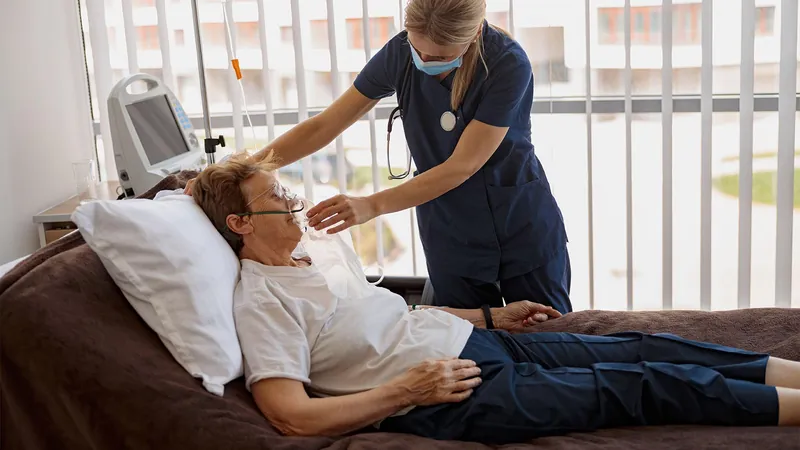
The Hidden Threat: RSV's Impact on Adults Rivals Flu and COVID-19
2024-11-13
Author: Ming
In a startling revelation, recent research has unveiled that respiratory syncytial virus (RSV) has been linked to severe health outcomes for adults, drawing parallels with influenza and COVID-19. Prior to the development and approval of RSV vaccines, the virus was responsible for significant rates of hospitalizations, ICU admissions, and even fatalities within adult populations, particularly among the older demographic.
Led by Dr. Fiona Havers from the Centers for Disease Control and Prevention (CDC), a cross-sectional analysis highlighted that during the 2016-2017 to the 2022-2023 respiratory seasons, RSV hospitalization rates fluctuated substantially. For instance, during the 2017-2018 season, the hospitalization rate soared to 76.2 per 100,000 adults, with adults aged 75 and older experiencing the highest rates, ranging between 244.7 to 411.4 per 100,000.
The findings, published in JAMA Network Open, are alarming. The analysis revealed annual estimates indicating that RSV-related ICU admissions ranged from 24,400 to nearly 35,000 cases, with in-hospital deaths peaking at over 8,600 during the 2017-2018 season. Havers emphasized that up to 136,000 annual hospitalizations were attributed to RSV in older adults alone, underscoring the virus’s critical role in respiratory illnesses and hospital disruptions.
What’s even more concerning is the comparative severity of RSV. Data illustrated that 19% of hospitalized patients with RSV required intensive care treatment, with a mortality rate of 4.3%. In contrast, similar metrics were observed for both COVID-19 and influenza cases, with 15.5% and 13.3% of patients requiring ICU support, respectively. These statistics reveal just how serious RSV can be, especially for older adults who accounted for a staggering 45.6% of RSV hospitalizations and 58.7% of in-hospital deaths from 2016-2023.
Despite the alarming data, it’s important to recognize that deaths related to RSV could be underreported, as many fatalities occurring post-discharge often go unrecorded. The urgency of addressing RSV was significantly heightened when the first-ever RSV vaccines, Arexvy and Abrysvo, were approved by the FDA earlier in 2023, creating new avenues for prevention among vulnerable populations.
The CDC now recommends that all individuals aged 75 and older, alongside younger adults aged 60 to 74 with heightened risks, receive the RSV vaccination to mitigate severe outcomes. Public health experts are rallying for increased vaccination uptake to combat the detrimental hospitalizations tied to RSV.
Interestingly, the study also noted unusual trends in RSV transmission patterns during the COVID-19 pandemic, where lower hospitalization rates were recorded in 2020-2021. However, a significant resurgence was evident in the 2022-2023 season, emphasizing the unpredictable nature of respiratory viruses.
Despite improvements in testing, awareness regarding RSV among healthcare professionals remains limited, contributing to the underdiagnosis of the virus. Between 2016 and 2017, only 43.5% of hospitalized adults with acute respiratory illness were tested for RSV, a figure that fortunately saw an increase to over 56% in the 2022-2023 season.
With RSV’s severity rivalling that of flu and COVID-19, and its substantial burden on older adults, it is increasingly vital for both healthcare sectors and the public to remain vigilant. The urgency to advance vaccine coverage among at-risk populations cannot be overstated and will be crucial in reducing hospitalizations and fatalities in the future.
Stay informed and protect yourself from the unseen dangers of RSV!




 Brasil (PT)
Brasil (PT)
 Canada (EN)
Canada (EN)
 Chile (ES)
Chile (ES)
 España (ES)
España (ES)
 France (FR)
France (FR)
 Hong Kong (EN)
Hong Kong (EN)
 Italia (IT)
Italia (IT)
 日本 (JA)
日本 (JA)
 Magyarország (HU)
Magyarország (HU)
 Norge (NO)
Norge (NO)
 Polska (PL)
Polska (PL)
 Schweiz (DE)
Schweiz (DE)
 Singapore (EN)
Singapore (EN)
 Sverige (SV)
Sverige (SV)
 Suomi (FI)
Suomi (FI)
 Türkiye (TR)
Türkiye (TR)